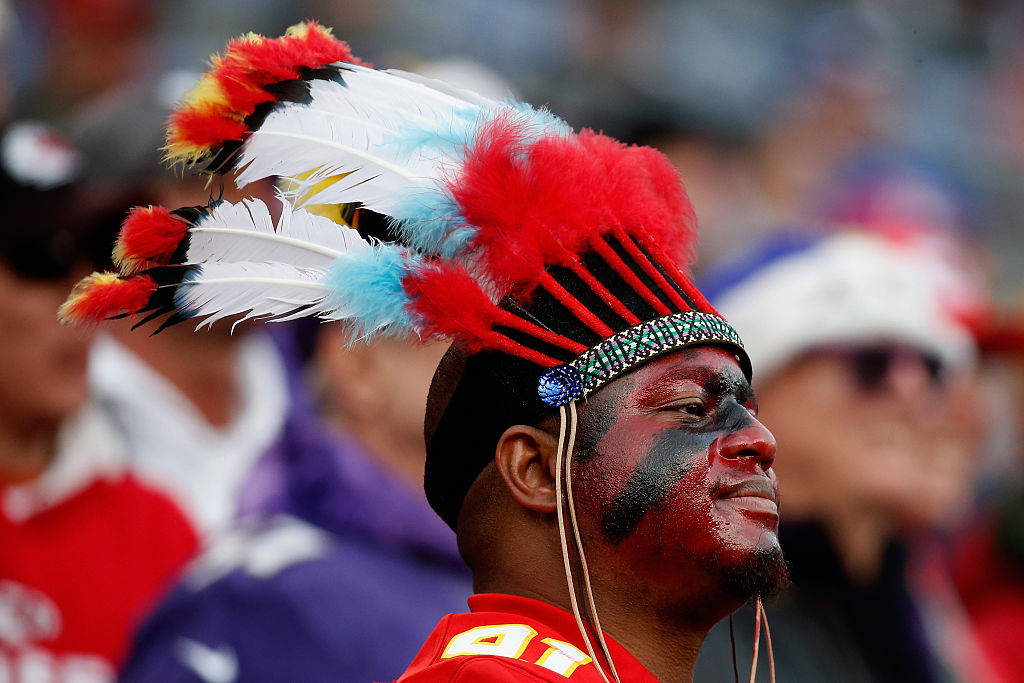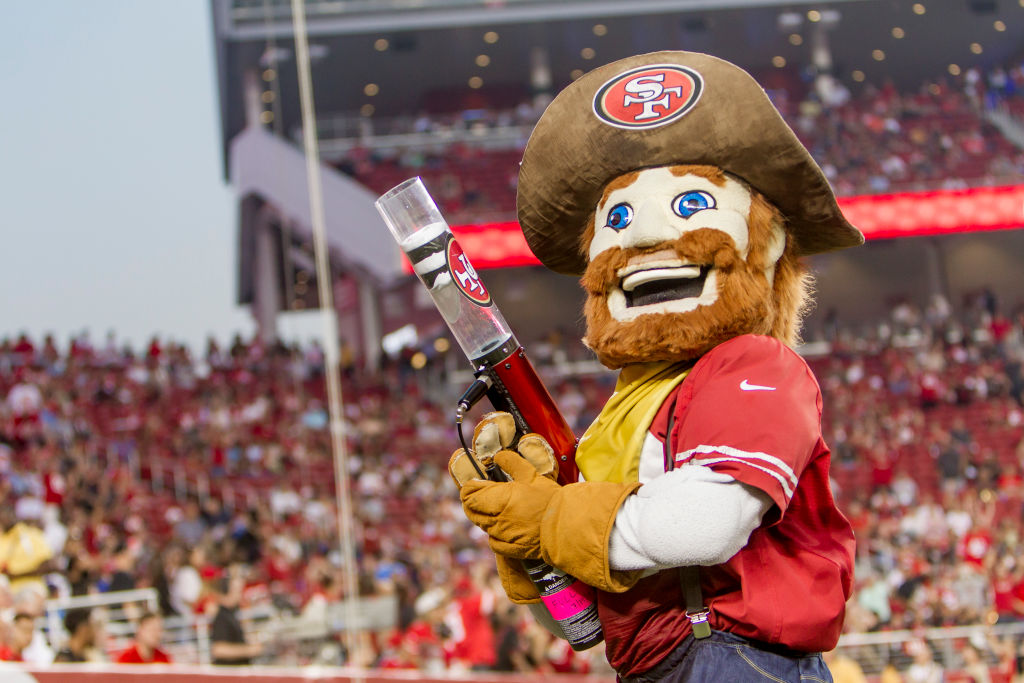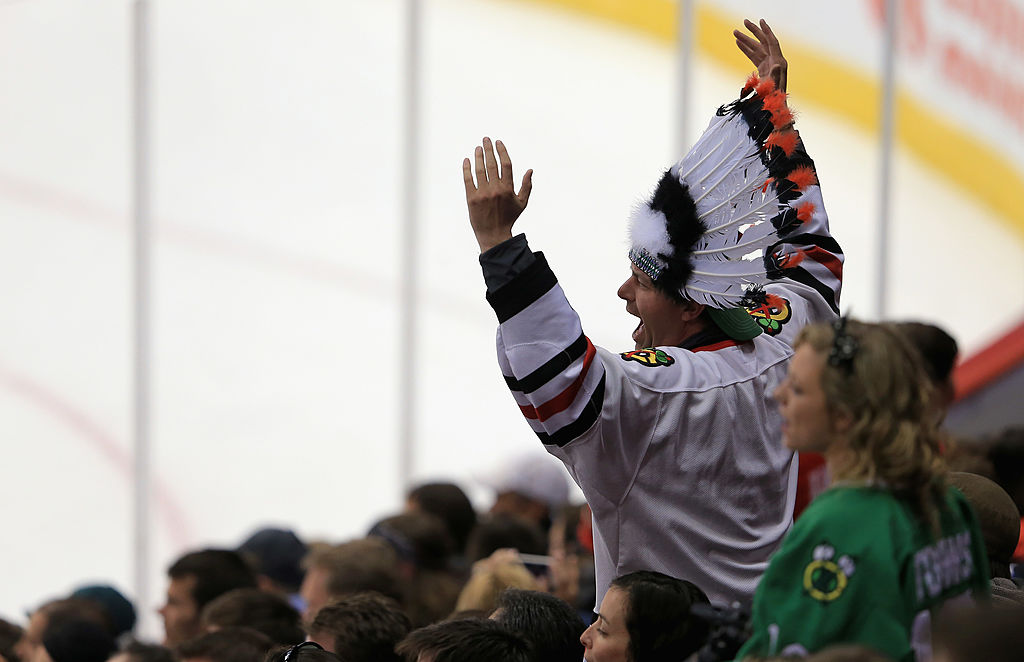With Super Bowl Sunday fast approaching, the rumbles have been growing on Native Twitter. Think pieces are being written on liberal and conservative outlets. And arguments are sure to break out between young and old family members at Super Bowl parties in Missouri and the Bay Area. Cold rage! Blind fury! Bickering over the nacho plate!
What’s causing this dust-up? Of the 32 teams in the NFL, two of three teams with overtly and covertly bigoted names that target Indigenous Americans are going to the Super Bowl. A classic case of America’s pastime (being racist) merging with its favorite game. Given this unique cultural moment, people are taking to their social media and journalism platforms to share takes, educate, and reflect on the state of not only the NFL in 2020 but the greater issue of our nebulous-but-supposedly-lofty “American values.”
Essentially, the question at the root of the issue boils down to this: Why is it still okay for Americans to wear redface and mock Indigenous pain in 2020? Seriously, help me get it. Blackface has been resoundingly jettisoned from our society. Race is an issue that defines our nation. So why are we still fair game?
I tend to be a glass-is-half-full kind of person. So for me, this can only boil down to education, or a lack thereof. The science backs me up on this. Americans (of all cultural backgrounds) are woefully uneducated — or, worse, miseducated — about anything pertaining to Indigenous history or our modern lives. The average American simply has no clue to the horrific nature of the actions taken by the United States and its citizens against Indigenous people from sea-to-shining-sea. Worse yet, there’s little to no purchase on the harrowing nature of Indigenous life today for the 572 nations that are living on Indian reservations across this country.
So let me try to keep that promise in the headline and explain why both names should be replaced. Not because of some left/right or politically correct/progressive agenda. Not for clicks. This is the history you need to know to understand exactly who you are. Indigenous people are real Americans that are living and suffering in the U.S. right now and, yes, your actions towards them — even relating to sports — make a difference.
THE CHIEFS — A Short History

When the NFL moved The Texans to Kansas City in the early 1960s, the team needed a new name. There was actually a write-in contest for local Kansas City denizens to name the team. The winner that shook out was an honorific for a local mayor whose nickname was “Chief.” This is due to said mayor starting a Boy Scout club that ripped off “Native American” rituals and paired it with Hollywood-inspired iconography, but that’s another fight for another day.
The name was in place, the team was in town, and logos needed to be made. An arrowhead was chosen. A relic of the stone age which, yes, represented weaponry used during the previous millennia but also helped solidify in people’s minds that the Indigenous people of the western plains were stone-age savages.
Naturally, it being the 1960s, the mascot the team chose was an “Indian” in a loincloth and face paint with feathers riding a horse named Warpaint. Again, confirming bigoted — and let’s be honest, Hollywood reinforced — images of what the average American perceived all Indigenous people to be.
That mascot was phased out in 1988 and a completely innocuous mascot, The K.C. Wolf, was introduced. That was a nice step. But shortly afterward, the “tomahawk” chop started making it’s way out of Florida and catching on with teams from Cleveland to Atlanta to Kansas City. That cheer still hasn’t died to this day. Meanwhile, Warpaint the horse is back. Though thankfully, neither the horse nor cheerleader riding in the saddle is donning any “Native American” regalia.
While the team’s philosophy has shifted (a little — here’s the team president talking about it like it’s some heritage-listed activity that must be preserved), the fans aren’t fully on board. Fake headdresses abound. Redface. Fake buckskin drums. The renamed “arrowhead chop.” Whopping and chanting. These are all mainstays of a Kansas City Chiefs game. So much so, that the New York Times wrote a feature this week talking about how the issue divides people (making one wonder, would other racist traditions get the “both sides” treatment from the paper of record?).
The bigoted behavior is so off-putting that the team asked TV broadcasters not to show these fans. Still, there are a lot of them. It will be hard to hide.
Why is this behavior offensive? Besides the fact that it equates an entire people with crude, blind violence, the region the team calls home is particularly fraught. Kansas City bridges two worlds — the Mississippi Valley cultures and the Great Plains. The wars between the U.S. and the settlers who wouldn’t stop moving west and the Kiowa, Missouri, Osage, Kansa, Pawnee, and Arapaho nations in the 1800s were famously brutal. Straight-up acts of genocide. To get a full view on the horrific nature of the war on the plains, listen to Daniele Bolelli’s amazing recounting on his History on Fire podcast focusing on the Sand Creek Massacre (one of the darkest chapters in U.S. history).
Moreover, the eastern reaches of Missouri were home to one of the more advanced agricultural and metal-working societies on the planet around 1500. Relics like Cahokia, the largest urban center in the Mississippian culture pre-colonization was a wonder to see. They unquestionably were not stone-age people riding horses in loincloths.
THE 49ERS — A Brief History

Let’s dive right into why this name is baffling. The 1849 Gold Rush and the Oregon Trail that fed it was an outright act of genocide. That’s not hyperbole. Between 1849 and the late 1870s, the United States government in conjunction with the territory of California enacted laws to legally exterminate the Indigenous people of California. The main thrust of the story is that the United States armed local “militias” thanks to the second amendment and sent them out on raiding parties. They’d raid Indigenous towns, kill all the men, and then take the women and children to slave markets to be sold to miners as free labor.
Not to compare the two, but there was a notable difference between the iteration of slavery happening in California and the plantation system of the American South. Where African slaves were seen as a chattel-based equity investment, Indigenous Californians were being enslaved to be worked to death and replaced until they were all gone. It was a single-generation system. To a 49er miner, an Indigenous woman or child was nothing more than a pick-ax — when it broke, you simply had to buy a new one. This slave trade lasted well into the 1870s with slave markets in San Francisco still functioning until they simply ran out of people to sell.
In the end, Calfornia’s Indigenous population fell by 80 percent over 25 years. And it didn’t end there. Laws by the U.S. government — like Greaser Act in the 1850s — sought to ethnically cleanse “Spanish Indians” from California. That was followed by the “Mexican Repatriation” movement in the 1920s and 1930s and Operation Wetback in the 1950s, which changed the government’s target from “Spanish Indians” to just “Mexicans.” Both titles were code for ethnically cleansing brown people, many with Indigenous backgrounds and almost all with American citizenship — expatriating people from the U.S. to present-day Mexico, where none of them had ever set foot.
So understand this: when Indigenous people see Sourdough Sam, the 49ers mascot, they may very well think of the sheer audacity it takes to whitewash an actual genocide with a smiling, blue-eyed miner rather than a folk hero. It’s a nod to the past, sure, but a shitty one. It’s also understandable. The California Genocide is not taught in schools. It barely makes a blip on the national consciousness.
SO WHAT NEXT?

It’s one thing for a population or group of sports fans to claim ignorance to all of this pre-2000. That excuse is gone, folks. We live in an age where the reality of America’s history with Indigenous people is easily accessible from the people living through the fallout of that history. In 2020, you don’t get to play the “well, I didn’t know card” anymore. You have wifi. There are history podcasts. It’s the U.S.’s responsibility to educate people on this but some of that falls on you, too.
That’s not to say that “everything is the worst.” Things are changing in some regards. As mentioned above, teams and broadcasters are refusing to show redface. The Cleveland Indians have walked back from Chief Wahoo. Companies are refusing to broker Redskins merchandise. Even in that image above, from a Chicago Blackhawks game, shows a single fan in a sea of fans who are not in fake headdresses. That, to me, provides some hope.
Still, seeing someone in redface or a fake headdress denotes colonial bigotry. So does the tomahawk chop. The 49er represents brutal manifest destiny and wealth capture at the expense of an entire population. The nation is coming to grips with that. These conversations are part of that process. And guess what? The don’t have to dead end. Names change all the time. The Anaheim “Mighty Ducks,” anyone? Houston Colt .45s? Nothing, ever, is set in stone.
“But this name is part of our team’s heritage!” scream the bad-faith Dan Snyders of the world. Sorry, pal, our heritage predates the NFL by a few millennia. Besides, would a single person in Kansas City be any less stoked if the Kansas City Wolves were going to the Super Bowl? They already have the mascot in place. That’s the easiest fix there is. And then, I have to ask, are we so blind to our own history that we want to cheer on a team that is, at the very least, covering up genocide and, at the very worst, celebrating one? Is that still who we are?
Let’s end by taking this out of the theoretical. Being unseen or unconsidered on the national stage is clearly harming the Indigenous community. It’s fueling the suicide rate amongst the youth and the dehumanization of Indigenous women. It’s also deepening stereotypes that are taking funds out of Indigenous people’s pockets while making it harder for them to get loans. Yes, this is about recognizing the past. But, more importantly, this is about recognizing what’s happening right now. And building a better future.

